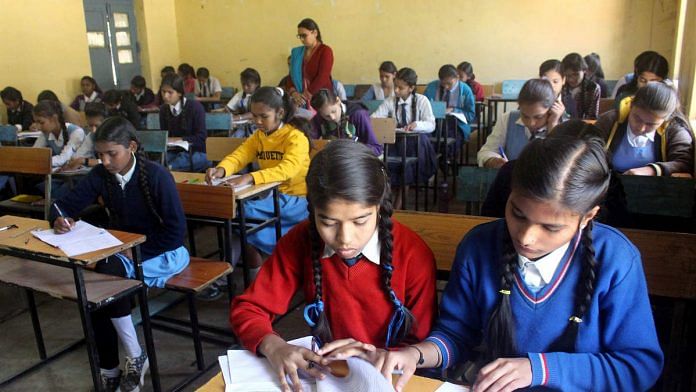New Delhi: School children will be taught safe use of internet and social media, reproductive health, prevention of HIV and gender stereotypes under the new ‘Health and Wellness Curriculum’ developed by the Narendra Modi-led NDA government.
The ministries of Human Resource Development and Health and Family Welfare developed the curriculum together, and it was launched by the respective ministers, Ramesh Pokhriyal ‘Nishank’ and Harsh Vardhan, on 12 February.
The curriculum also includes sex education, even though the phrase itself hasn’t been used anywhere in the document, which has been accessed by ThePrint. Instead, the phrase used is ‘adolescence education’. This was earlier a separate curriculum, but has now been merged with this.
To start with, the National Council for Education Research and Training (NCERT) has come up with the programme for classes 6 to 10. It will further develop modules for classes 11 and 12.
Also read: RSS-backed body says no need for sex education, doesn’t want it in New Education Policy
Growing up healthy
The curriculum focuses on teaching things beyond what classroom textbooks teach and will be covered in 24 weeks. Children will be taught the curriculum through comic strips, role playing, group discussions and classroom activities.
The curriculum has been divided into 11 modules — growing up healthy; emotional well-being and mental health; interpersonal relationships; values and responsible citizenship; gender equality; nutrition, health and sanitation; promotion of healthy lifestyles; prevention and management of substance misuse; reproductive health and HIV prevention; safety and security against violence and injuries; and promotion of safe use of internet, media and social media.
Lessons on subjects such as menstruation and nocturnal emissions for children hitting puberty are a part of the module called ‘growing up healthy’. The curriculum explains the phenomenon of young boys hitting puberty through a comic strip that shows a child feeling embarrassed about having a nocturnal emission when he wakes up with wet pants. The child then speaks to his older brother about it, who tells him that it’s all natural at his age.
The module mentions various case studies about children hitting puberty, and teachers have been asked to discuss various scenarios with students through role play.
For teaching the misuse of social media and internet, the study module suggests that students should be asked to write how much time they spend on social media, internet and other activities, and what they gain out of it, so that they can understand the advantages and disadvantages.
NCERT officials say there was a huge demand for teaching the correct use of social media to schoolchildren.
Also read: There’s only one way to tackle India’s sexual violence epidemic – sex education
Busting gender stereotypes
The curriculum also includes a module on gender equality, which teaches students about gender stereotypes and tries to bust them. “Gender is socially constructed and thus can be changed over time. We are all equal and deserve to be treated equally,” the module says.
As an activity to understand gender roles, students have been asked to draw a chart, with tasks such as washing clothes, playing a sport or listening to music on one side, and who spends more time in performing them on the other.
At the end of the activity, a message tells students that, “if given an opportunity, girls, boys and trans-genders are capable and should perform all kinds of tasks and work within the household as well as outside”.
“When individuals are treated in an unequal manner and are denied certain rights on the basis of their gender, it is called gender-based discrimination. Gender discrimination may affect girls, trans-genders and boys,” the module adds.
Also read: In breaking transgender stereotypes in Delhi govt schools, this NGO junked its own
Who will teach?
Under this curriculum, two teachers, preferably one male and one female, will be appointed as ‘health and wellness ambassadors’ for students. The training of these teachers will begin shortly, and they are expected to start teaching children from the coming academic session in July.
“A National Resource Group of 40-50 people will be formed, which will further train teachers in states. The curriculum will be implemented in government schools to start with, and then we will take it private schools,” said an NCERT official.
Officials said the curriculum has been developed after extensive research of more than two years by a team over 80 people from the health ministry, NCERT, NGOs working in health sector, and other subject experts.
“NCERT had invited public suggestions for a separate project related to children, and we got feedback that children should be taught about the misuse of social media, busting gender stereotypes and internet usage, which is why it was decided that all of this will be included in a single curriculum,” said another NCERT official who has worked on the curriculum.
“We have merged adolescence education also in this curriculum so that it is easier for the educators to cover all aspects related to teenage children.”
Also read: ‘Students losing interest’, NCERT gets book to teach maths through rhyme, riddle & story




Good idea provided the teachers themselves do not abuse the children and children correctly understand the subject.